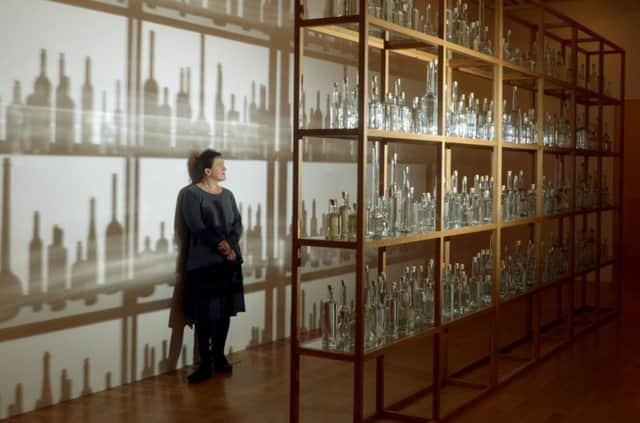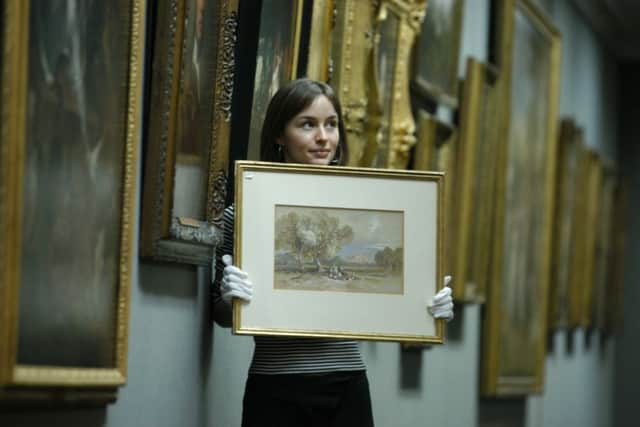Arts reviewL Tania Kovats |Edward Lear


TANIA KOVATS: OCEANS
Fruitmarket Gallery, Edinburgh
* * *


EDWARD LEAR IN GREECE
Scottish National Gallery, Edinburgh
* * * *
The centrepiece of her exhibition is All the Sea, a collection of 227 bottles of water from what, worldwide, we choose to call seas. She is 23 short of the complete collection, so there are also 23 empty bottles. The people who have collected these specimens are all named and there is even a slideshow of them at the various seasides. One problem Kovats has, however, is that water looks much the same wherever it comes from. To get round this she has chosen bottles of all shapes and sizes. The result does look a bit like a whimsical bottle collection.
Nearby, Only Blue is a pile of 40 out-of-date atlases lying open so that together they display the whole map of the world. All the land masses are obliterated with white gesso, however, leaving, as the title indicates, only the conventional blue of the sea. But of course, what is left is not just the sea. There are place names all around the coasts and at several points international frontiers are marked on the water. Though the choice of obsolete atlases may be intended to contrast the permanence of the seas to the transience of human politics, it doesn’t quite work. The politics show through. It also poses another question, for surely this is all very Euro-centric? The names of the seas and even what is or is not classified as such vary from language to language. This may indeed be why, in a work called Where Seas Meet, she has, perhaps inadvertently, included a sea that’s not a sea. Flasks of water containing water from different, contiguous seas are joined together. In one triplet, however, the flasks are labelled respectively Bengal, Indian and Arabian. The Bay of Bengal, however, is not a sea – which seems rather to defeat the point, for the whole exercise appears to hinge on the often arbitrary but also poetic distinction we make in our nomenclature between a sea and all the other stretches of water in the world.
Advertisement
Hide AdThe sea is notionally present in the rather beautiful, accidental drawings Kovats makes with blotting paper, ink and salt water, combined and allowed to evaporate. Silver Sea, on the other hand, is an actual drawing and on a grand scale. She uses Indian ink on silvered paper to emulate the effect of light on water. The formalised design is a variation on Mondrian’s early sea pieces, one of which she also illustrates in Drawing Water, the book that accompanies her show. In the drawing a repeated lozenge shape suggests light on the ripples of water and, as the lozenges diminish in size, they also suggest recession to a high horizon. She has then reworked this composition in ceramic tiles, dark blue against buff. Ceramic is a glorious medium – think of Miró’s great ceramic walls – but given the grandeur that is possible, the rather monotonous surface she has chosen is a disappointment.
There is an intimate connection between water and geology, and Kovats has followed this logic to shift from one to the other. Bridging the gap, Rain, a drawing of spots of ink on blotting paper, emulates the action of water that, though so gentle, can shape the hardest rock. Sculptures made of barnacles also suggest a crossover between the geological and the organic, but then she has gone on to demonstrate actual geological forms and processes in wax models of the layering of schist. There is even a mechanical model to demonstrate how this stone is deformed by pressure. There are other geological models too, including a nicely rendered sea stack with its adjacent cliffs. It seems oddly to be labelled Peninsula, but this may be my mistake. The labelling throughout is a bit confusing. Nevertheless, this part of the exhibition surely belongs more in a natural history museum than an art gallery.
Altogether this is an earnest though amiable show, but in those lines from Burns the rocks and seas are transfigured by poetry. That doesn’t really happen here. Art is a kind of alchemy: base metal turned to gold or, if you will, water into wine. There is not much gold here and Kovats’s water remains just a little too watery. Likewise the book, Drawing Water, is a charming miscellany of drawings, maps and bits of text, but, like a Victorian keepsake book, it is no more than that.
Kovats’s show is essentially documentary, and if there is a link to Edward Lear in Greece at the Scottish National Gallery, that is it. Lear too was concerned with the documentary, or at least with documenting the topographical. “To topographize and topographize all the journeyings of my life” was his declared ambition.
He did travel in the Near East, but much of his journeying was in Greece, and this collection of drawings put together by the historian Sir Steven Runciman is exclusively of Greece and its islands. Many are of Corfu which, under British dominion in the mid-19th century, was Lear’s base for years. But there are also drawings recording his travels throughout the Ionian Islands and into the mountains of the north-western mainland, as well as south to Crete and east to Athens.
Lear’s habit was to work up into finished paintings, or for publication as lithographs, drawings that he had done on the spot in pen, ink and watercolour. Many of the 25 drawings here are these first, more informal sketches and consequently they capture the freshness of his response. On these informal drawings, he often also adds documentary details, noting the time of day, or making jottings about colour, vegetation or other features of the scene. In one spectacular view in the mountains of northwestern Greece, he has, for instance, labelled a dramatic abyss “Immense!” In a drawing of Kythera, the island where Venus/Aphrodite was born from the sea, he has added a lightly drawn image of her rising from the waves, à la Botticelli.
Advertisement
Hide AdLear’s style is generally understated, as befits his documentary intention, but the effect of the wild mountains beyond the hilltop fortress of Suli, for instance, is all the more impressive for this restraint. As well as the landscape, he draws the architecture with precision and documents the people in their distinctive costumes.
His paintings are coolly beautiful, but Lear the artist was also Lear the author who gave us The Owl and the Pussycat and other well-loved comic verses. Though it doesn’t show in his drawings, this side of his character does come out in his comments about places he drew. Zante (or Zakynthos) is famous for its currants, but in Lear’s view it did not deserve to be for its landscape. It was, he wrote, “one unbroken contrivance of future currant dumplings and plum puddings”.
Advertisement
Hide AdThere are also several beautiful drawings of Mount Athos, but though he admired their monasteries, he did not like the monks one bit. With eloquent alliteration he recorded his vehement dislike of “these miserable, mutton-hating, man-avoiding, mysoginic (sic), morose and merriment-marring, monotoning, many-mule-making, mocking, mournful, minced fish and marmalade-masticating Monx.”
Minced fish and marmalade? To be eaten with a runcible spoon perhaps.
• Tania Kovats until 25 May
• Edward Lear until 8 June